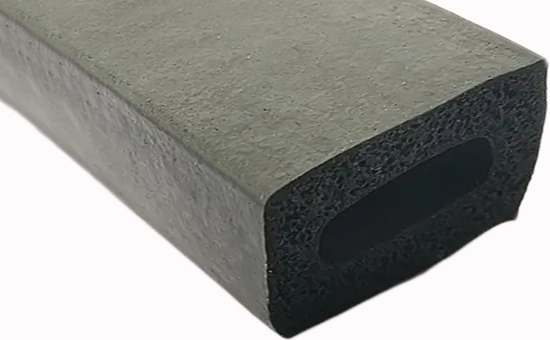EPDM recycled rubber has excellent high and low temperature resistance, weather resistance, and aging resistance, and can be used alone or in combination with EPDM rubber to produce various foamed rubber products such as EPDM foam sealing strips, which can effectively reduce the cost of raw materials. When EPDM reclaimed rubber is used to produce sponge foamed rubber products, the formula design directly affects the quality and cost of the finished product; When designing the foaming formula of EPDM recycled rubber, it is necessary to fully consider the selection of raw rubber, vulcanization system and foaming system.
1. Raw rubber selection of EPDM recycled rubber foaming formula
In actual production, EPDM rubber is usually used when sponge foamed rubber products have high requirements for heat resistance and aging resistance, such as automobile door and window seals. When using EPDM reclaimed rubber instead of original rubber to produce low-cost foamed products, it is necessary to select the appropriate EPDM reclaimed rubber according to the specific performance requirements of the products, and it is advisable to be close to its physical properties. When EPDM foamed products are required to be environmentally friendly and odorless, it is necessary to use environmentally friendly EPDM reclaimed rubber and odorless EPDM reclaimed rubber that can provide relevant test reports.
2. Vulcanization system of EPDM recycled rubber foaming formula
The vulcanization systems commonly used in the production of EPDM recycled rubber products are sulfur vulcanization system and peroxide vulcanization system. Among them, sulfur vulcanized rubber has high mechanical strength and low cost, but the heat aging resistance of rubber is poor. The vulcanized EPDM reclaimed rubber with peroxide vulcanization system has excellent aging resistance, but its mechanical strength is low and the cost is high. The design of the vulcanization system of EPDM recycled rubber foaming formula not only needs to consider factors such as vulcanization speed, physical and mechanical properties, aging resistance and whether it is easy to spray frost, but also needs to pay attention to the cooperation with the foaming system.

When using EPDM recycled rubber to produce sponge foamed rubber products, the design principle of the vulcanization system is to match the vulcanization rate of the rubber compound with the decomposition rate of the blowing agent. It is suggested that the vulcanization system of EPDM recycled rubber 2SLYY1130 foaming formula should be selected according to the required performance and cost considerations, and one or more combinations of vulcanization systems should be selected. For example, a sulfur vulcanization system may be used in combination with a peroxide vulcanization system to improve heat and aging resistance, and to better coordinate the vulcanization rate with the foaming rate while remaining cost-effective.
3. Foaming system of EPDM recycled rubber foaming formula
When choosing a blowing agent, you need to pay attention to the following points: decomposition temperature; the amount of decomposed gas; the amount of heat produced during decomposition (exothermic and endothermic); Hygienic properties such as odor and toxicity of decomposition gases and decomposition products; dispersion properties during mixing; compatibility with raw rubber; compatibility with vulcanization systems; contamination of the product; operational safety; storage stability, etc.

In the design of EPDM recycled rubber foaming system, the selection of appropriate vulcanization system and blowing agent is the key. Sulfur vulcanization system is usually used, combined with accelerators such as PZ (zinc dimethyl dithiocarbamate) and ZDC (zinc diethyldithiocarbamate) to achieve rapid vulcanization and form an epidermal layer to improve the strength of sponge rubber. In addition, the amount of accelerator needs to be precisely controlled to avoid scorching and frosting of the product during processing.
The choice of blowing agent has a significant impact on the vulcanization behavior and foaming effect. The commonly used blowing agents for EPDM reclaimed rubber foaming formulations include H, AC, OBSH, etc., which affect the decomposition temperature and vulcanization rate through their interaction with vulcanization accelerators. For example, the decomposition by-product of foaming agent H has the function of accelerator, which can speed up the start of vulcanization; The decomposition by-product of the blowing agent OBSH is acidic substance, which will reduce the effect of the compounding agent in the vulcanization system, thereby reducing the vulcanization rate and density.
In practical application, the foaming rate and density of sponge rubber can be controlled by adjusting the type and amount of blowing agent. For example, the increase in the amount of foaming agent AC can improve the foaming rate of sponge rubber; However, even if the dosage of blowing agent OBSH is increased, it is difficult to increase the foaming rate, because the vulcanization delay is also enhanced when the dosage increases, resulting in foaming before vulcanization and causing outgassing. In addition, the sponge rubber with foaming agent OBSH has a higher water absorption, indicating that it is easier to make sponge rubber with many open holes.
The design of EPDM reclaimed rubber foaming formula needs to comprehensively consider the vulcanization system, the type and amount of blowing agent, and the interaction among them. Proper adjustment of the foaming formula can produce EPDM reclaimed rubber sponge glue with better performance to meet the needs of different application fields.
Exclusive original article [commercial authorization] reprint, excerpt and excerpt in any form are prohibited without written authorization. Focus on Hongyun rubber: learn the process formula and raw material technology of producing rubber products from recycled rubber to help you reduce costs and increase profits